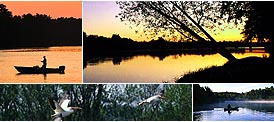
| Redfish | Sailfish | Sharks | Sheepshead | Snapper | Snook | Spanish Mackerel | Spotted Seatrout | Tarpon |

DOLPHIN
Regulations
No minimum size or closed season; 10 per person per day limit
General Information
A strictly open water fish with striking colors. The body is golden iridescent with a deep green dorsal fin speckled with blue. Females spawn from November through July and produce eggs that, if they survive, will become 36" fish by the time they are one year old.
Dolphin travel in schools consisting of fish of approximately the same age and size. Fish less than three pounds are called chickens. Schoolies range from three to eight pounds. Gaffers are in excess of 8 pounds and are so called because a gaff is necessary in order to get the fish in the boat. The largest dolphin are slammers. These include the jumbo sized males referred to as bulls, fish easily distinguished by the distinctive lobed forehead.
Distribution
Dolphin are year round residents in south Florida. They regularly move north along the Atlantic coast in the summertime via the Gulf Stream. They also migrate to the northern Gulf of Mexico where there is a viable sportfishery based along the panhandle coast. Anglers along the west central and southwest coast must travel at least 50 miles offshore to find these fish as they migrate up and down the coast.
Tackle and Techniques
Dolphin love to hang around anything that floats. This includes lines or patches of seaweed and any type of man made or natural floating debris. Even one small piece of material is enough to attract a small school of chickens of schoolies. Never pass up the opportunity to cast your bait around floating objects.
In the absence of floating material trolling is another reliable way to find the fish. Boats usually run several lines overboard at the same time. Don't be surprised if you get one fish on and suddenly find every rod bending under the strain of a fish. Remember, dolphin travel in schools.
Boat tackle with 20 pound test line or higher works for trolling. When casting, a medium duty spinning reel with 15 pound test line will work on the smaller and medium sized fish.
Bait
A rigged ballyhoo is the traditional trolling bait, but one of the specially designed dolphin and big game lures also bring in their fare share of fish. When casting around floating debris, use cut bait or a ballyhoo. If the fish are around and a feeding frenzy develops, lures, jigs or anything light colored and flashy will get a strike.
Secrets to Success
* When you catch the first fish, leave it in the water. Chances are very good that other dolphin will show up to keep the hooked fish company.












